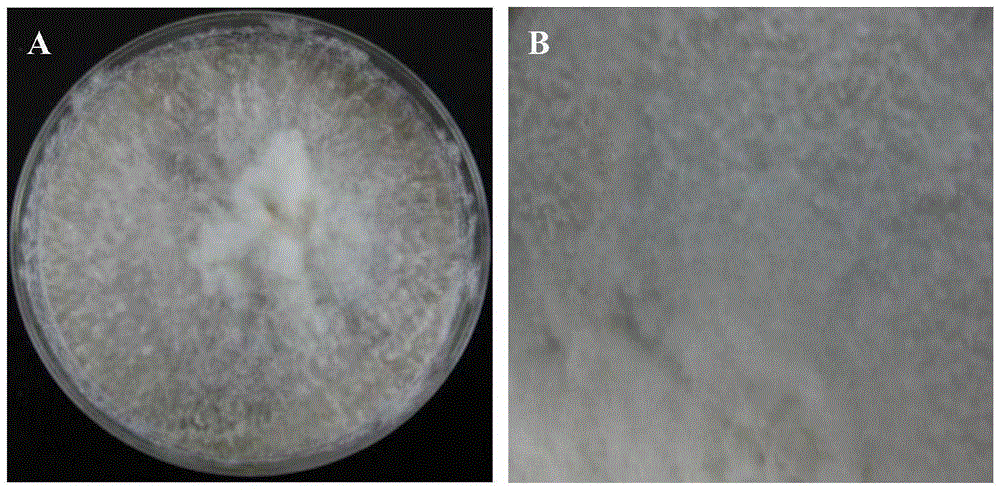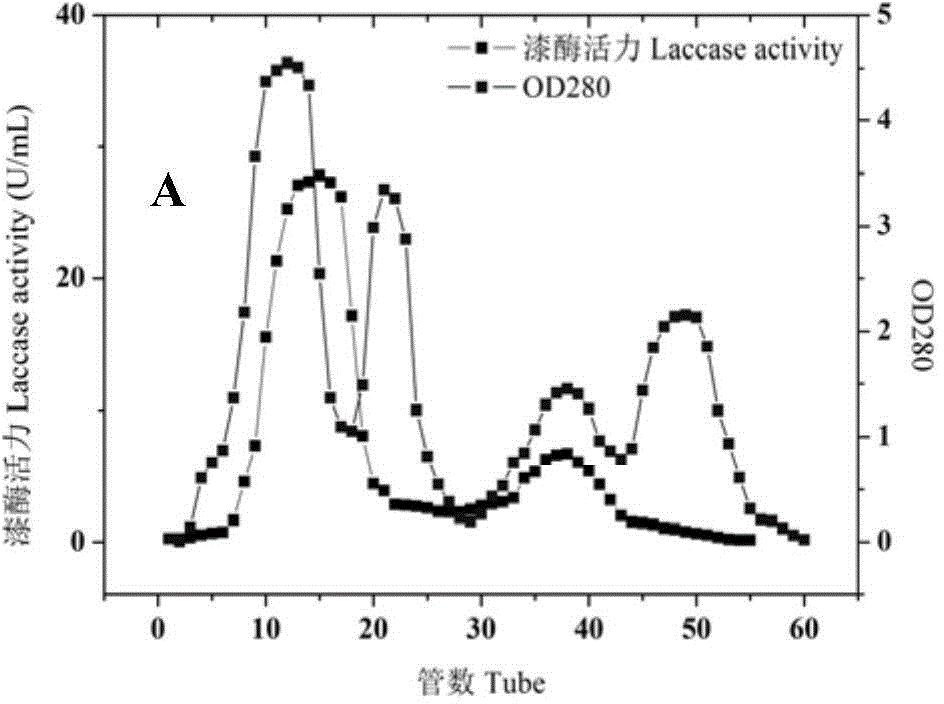Bacterial strain for producing laccase, method for producing laccase by bacterial strain, produced laccase and application of laccase
A technology of laccase and bacterial strains, which is applied in the field of microbial enzymology, can solve the problems of weak tolerance, hindrance to large-scale commercial application, low activity and yield of laccase, and achieve easy operation, high tolerance and high activity. Effect
- Summary
- Abstract
- Description
- Claims
- Application Information
AI Technical Summary
Benefits of technology
Problems solved by technology
Method used
Image
Examples
Embodiment 1
[0047] Example 1 culture medium
[0048] 1. Separation and purification medium
[0049] Glucose 20.0g / L, malt extract powder 20.0g / L, agar 25.0g / L, KH 2 PO 4 3.0g / L, penicillin 0.2g / L, streptomycin 0.2g / L, deionized water 1000mL, pH natural, 1×10 5 Pa autoclave for 30 minutes, add penicillin and streptomycin when the temperature is lowered to ≤40°C, shake well, distribute in plates, and store at 4°C after cooling for later use.
[0050] 2. Preserve slant culture medium
[0051] Glucose 20.0g / L, malt extract powder 20.0g / L, agar 25.0g / L, KH 2 PO 4 3.0g / L, 1000mL deionized water, natural pH; 1×10 5 After Pa autoclaving for 30 minutes, place the test tube rack at an angle to make the culture medium slope, and store it at 4°C after cooling for later use.
[0052] 3. Activation medium (solid plate medium)
[0053] Glucose 20.0g / L, yeast extract powder 5.0g / L, agar powder 20.0g / L, KH 2 PO 4 1.0g / L, MgSO 4 ·7H 2 O0.5g / L, ZnSO 4 ·7H 2 O 50mg / L, vitamin B110mg / L, deionize...
Embodiment 2
[0056] Example 2 Isolation, purification and identification of Trametes pubescens BJFC-C1108
[0057] 1. Isolation and purification of Trametes pubescens BJFC-C1108
[0058] The bacterial strain of the present invention is isolated from fallen logs of Castanopsis chinensis in Chebaling Nature Reserve of Guangdong Province.
[0059] The white rot fungus Trametes tomentosa was collected from the fallen logs of Castanopsis chinensis in Chebaling Nature Reserve, Guangdong Province. The fresh fruiting body was carefully peeled off from the substrate with a collection knife, and impurities irrelevant to the fruiting body were removed as much as possible. workbench ( ), cut the fungus flesh near the base of the fruiting body (the size is about 3.5cm×3.5cm×3.5cm, and the vegetative hyphae at the base of the fruiting body grow the most vigorously) and inoculate it on the separation and purification plate medium, at 28±3 After static culture at constant temperature at ℃ for 7-8 days,...
Embodiment 3
[0068] Example 3 Preparation and purification of laccase Tplac by fermenting Trametes pubescens BJFC-C1108
[0069] 1. Preparation of Trametes villosa bacteria cake
[0070] Inoculate the purified Trametes pubescens BJFC-C1108 strain on the activated solid medium, culture it statically at 28±3°C for 7-8 days, and then pass through a hole puncher with a diameter of 1 cm to make the villous plug hole Bacteria Cake.
[0071] 2. Preparation of fermented seed suspension
[0072] Inoculate the bacteria cake of Trametes versicolor into a 250mL Erlenmeyer flask containing 100mL of liquid medium, and culture it with shaking at 28±3°C and 150rpm. After 6 days, use an in-cut homogenizer at 5000 rpm for 30 seconds to homogenate, and oscillate fully to obtain a suspension of fermented seeds of Trametes villiformis.
[0073] 3. Fermentation culture
[0074] The fermented seed suspension of Trametes villiformis was added to a 250mL Erlenmeyer flask containing 100mL liquid fermentation me...
PUM
| Property | Measurement | Unit |
|---|---|---|
| Diameter | aaaaa | aaaaa |
| Specific vitality | aaaaa | aaaaa |
| Concentration | aaaaa | aaaaa |
Abstract
Description
Claims
Application Information
 Login to View More
Login to View More - R&D
- Intellectual Property
- Life Sciences
- Materials
- Tech Scout
- Unparalleled Data Quality
- Higher Quality Content
- 60% Fewer Hallucinations
Browse by: Latest US Patents, China's latest patents, Technical Efficacy Thesaurus, Application Domain, Technology Topic, Popular Technical Reports.
© 2025 PatSnap. All rights reserved.Legal|Privacy policy|Modern Slavery Act Transparency Statement|Sitemap|About US| Contact US: help@patsnap.com



